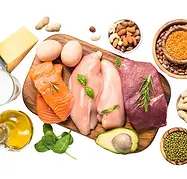
Protein In Food
The Ultimate Guide to Protein in Foods
Proteins are macromolecules of amino acids linked together into a complex structure. Amino acids are the building blocks of proteins. There are 20 different types of amino acids. One of these 20 types, nine are essential amino acids, as they either can not be made in the body at all or can not be made in the quantities needed. You must get essential amino acids from food for your body to function normally.
The nine essential amino acids are histidine, leucine, isoleucine, lysine, methionine, phenylalanine, tryptophan, threonine, and valine. The remaining eleven amino acids can be made in the body, called nonessential amino acids.
The eleven nonessential amino acids include alanine, arginine, asparagine, aspartic acid, cysteine, glutamic acid, glutamine, glycine, proline, serine, and tyrosine.

Protein is found in animal and plant foods. The amount of protein in food varies. Among plant foods, legumes, and nuts are excellent sources of protein. Animal foods like beef, chicken, and fish have more protein than plant foods. Most meats, poultry, and fish provide at least 20 grams of protein in a three-ounce serving.
.webp)
_edited.jpg)
Grains and vegetables provide some protein. For example, one slice of bread gives you about 4 grams of protein depending on the make and brand of the bread.